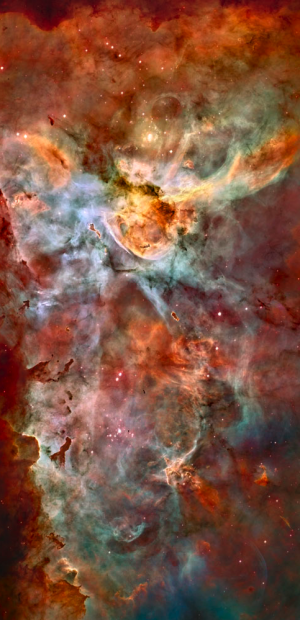(2007 photo: Cariana Nebula imaged with ACS and CTIO; credit: NASA, ESA, N. Smith, STScI, AURA, NOAO, NSF)
 After a nail-biting EVA 1 Thursday in which a stubborn bolt nearly derailed plans to install the new Wide Field Camera 3, and a marathon 8-hour EVA 2 Friday (the 8th longest spacewalk ever), Grunsfeld and Feutsel needed only six and a half hours to complete a smooth EVA 3.
After a nail-biting EVA 1 Thursday in which a stubborn bolt nearly derailed plans to install the new Wide Field Camera 3, and a marathon 8-hour EVA 2 Friday (the 8th longest spacewalk ever), Grunsfeld and Feutsel needed only six and a half hours to complete a smooth EVA 3.What makes their quick work all the more remarkable is that ACS was never designed to be repaired in the ways it was Saturday. Astronauts were tasked with removing 32 tiny screws before gaining access to replace four circuit boards and a power supply. Grunsfeld had been training hard practicing the repair and even wearing the big bulky space gloves in his down time to strengthen and accustom his hands. He was publicly confident the task could be accomplished in a single EVA, though extra time was built in to the final EVA 5 Monday to finish the job if necessary.
SM4 had been dubbed the most challenging Hubble servicing mission yet, jam packed with difficult jobs. Any complications and delays installing WFC3 and COS (the highest priorities) would leave the ACS and STIS repairs on the chopping block. Astronomers such as myself were a bit worried.
Fortunately, all is on schedule and EVA 3 went extremely smoothly. The hardest part for Grunsfeld Saturday seemed to come during his repair of ACS when Mission Control teased him about the beautiful view of Hawaii he was missing below. After wrapping up his work in quick order, Grunsfeld had time to enjoy the view during their next pass over the islands, even picking out the Keck telescopes down on the big island.
It was Grunsfeld, the astronomer-turned-astronaut, who originally installed ACS on Hubble back in 2002. So I can understood if he sounded a bit moved after bringing her back to life. After packing up his baby for another journey through the cosmos, we heard him bid it farewell, "Bye ACS!"
SM4 continues on schedule Sunday with EVA 4, featuring the repair of STIS. The full timeline and info about the instruments both new and old can be found in my previous post. More details and SM4 updates can be found on this NASA page.





Comments